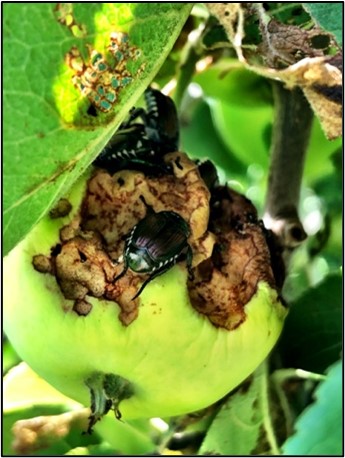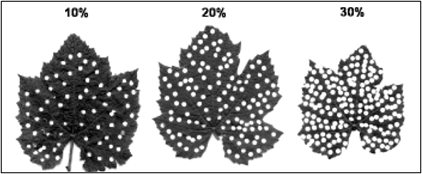Managing Japanese Beetle in Apple

Japanese beetles have barely started to emerge in Wisconsin and they have become worrisome for apple growers in the last couple years. Japanese beetles are voracious feeders, primarily skeletonizing leaves by feeding between leaf veins, but they sometimes also feed on flower buds, flowers, and fruit depending on the host plant. The impact of Japanese beetle in apple was discussed in a video interview last summer where I mentioned previous research showing that Japanese beetle were not able to feed on intact apple fruit of SweeTango but were able to feed on cut fruit1. Japanese beetles have been observed feeding on some apple fruit cultivars (Fig. 1), including Honeycrisp, Lodi, and Pristine. Japanese beetle adults feeding on apple fruit does not necessarily mean that they caused the initial damage, but rather that beetles were likely feeding on previously-damaged fruit.
Japanese beetle exhibit strong varietal preferences between plants and plant cultivars and it seems that cultivar preference is also happening in apple, with new research at the University of Minnesota suggesting preference for Honeycrisp over Zestar!® and more research is warranted to determine the underlying reasons for this preference.

While Japanese beetle are voracious feeders and can aggregate in large number on a single tree, they are unlikely to cause significant damage to apple trees from defoliation alone. UMN research described defoliation to be on average 4% of the total canopy per tree in Honeycrisp and 1% in Zestar!®. Thus, while the damage to a single leaf or a group of leaves may seem alarming, it is important to take the entire tree foliage into account when estimating percent defoliation. While no research has yet linked defoliation by Japanese beetle on apple tree health, growth, or fruit production, it is likely that apple trees can tolerate 20-30% defoliation (Fig. 2) without any significant impact on tree health. It is unlikely that apple trees in Wisconsin will experience such levels of defoliation, but in the event that an outbreak of Japanese beetle was observed, young trees, preferred cultivars such as Honeycrisp, Lodi, and Pristine, and high density orchards with small leaf canopies should be monitored. In the event that an insecticide should be applied, refer to the Midwest Fruit Pest Management Guide for chemical recommendations.
Happy growing season!
References
1Evaldo Martins Pires and Robert L Koch. 2020. Japanese beetle feeding and survival on apple fruits. Bioscience Journal, Volume 36, Issue 4, p. 1327-1334. https://doi.org/10.14393/BJ-v36n4a2020-50364
This article was posted in Apples, Insects and tagged Apples, Christelle Guédot, Japanese Beetles.
